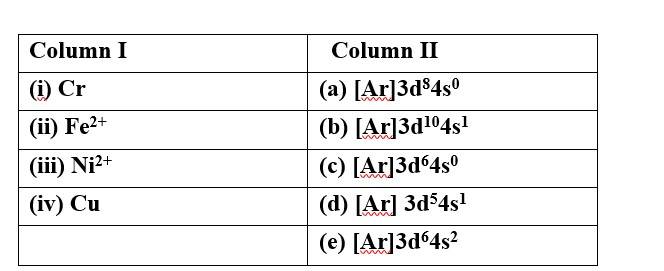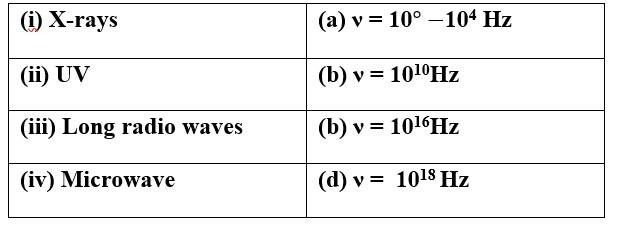Class 11th
Get insights from 8k questions on Class 11th, answered by students, alumni, and experts. You may also ask and answer any question you like about Class 11th
Follow Ask QuestionQuestions
Discussions
Active Users
Followers
New answer posted
5 months agoContributor-Level 10
This is a Assertion and Reason Type Questions as classified in NCERT Exemplar
Ans: option (ii)
The black body is the ideal body that absorbs and emits radiation of all frequencies. The radiation that it emits is said to be black body radiation. With an increase of temperature, the frequency of the black body radiation increases.
New answer posted
5 months agoContributor-Level 10
This is a Assertion and Reason Type Questions as classified in NCERT Exemplar
Ans: option (i)
As the chemical properties depend upon the number of electrons present in the atom thus the isotopes resemble the same chemical properties as they have the same number of electrons i.e. atomic number.
New answer posted
5 months agoContributor-Level 10
This is a Multiple Choice Questions as classified in NCERT Exemplar
Option (C)
(A) The molecule of a compound is obtained when two or more atoms of different elements are combined together.
(B) A compound can be separated into its constituent elements by physical methods of separation.
(C) A compound does not retains the physical and chemical properties of its constituent elements.
(D) When two elements react to form two or more than two chemical compounds, the ratio between different masses of one of the elements combining with a fixed mass of the other.
New answer posted
5 months agoContributor-Level 10
This is a Multiple Choice Questions as classified in NCERT Exemplar
Option (A)
The density (d ) is given by the formula:
d =
Here, m is the mass and v is the volume
On substituting the values in the above equation:
3.12 g mL-1 = M = 4.68 g
The mass will be 4.7 upto 2 significant figure.
New answer posted
5 months agoContributor-Level 10
This is a Matching Type Questions as classified in NCERT Exemplar
Ans:
(i) Cr (d) [Ar] 3d54s2
(ii) Fe2+ (c) [Ar]3d64s0
(iii)Ni2+ (a) [Ar]3d84s0
(iv)Cu (b) [Ar]3d104s1
New answer posted
5 months agoContributor-Level 10
This is a Multiple Choice Questions as classified in NCERT Exemplar
Option (C)
The empirical formula mass of CH2O is 30 g
The relation between empirical and molecular formula is given as,
n = …. (1)
On substituting the values in equation (1)
n = = 6
Thus, the molecular formula of the compound will be,
Molecular formula of the compound = (CH2O)6 = C6H12O6
New answer posted
5 months agoContributor-Level 10
This is a Matching Type Questions as classified in NCERT Exemplar
Ans:
(i) Photon (d) Exhibits both momentum and wavelength
(ii) Electron (d) Exhibits both momentum and wavelength
(iii) ψ 2 (b) Probability density
(c) Always positive value
(iv) Principal quantum (a) Value is 4 for N shell
number n (c) Always positive value
New answer posted
5 months agoContributor-Level 10
This is a Multiple Choice Questions as classified in NCERT Exemplar
Option (B)
The molar mass of carbon is 44 g mol-1
44 g of carbon dioxide contains 12 g of carbon
The percentage composition is given as, % composition
=
On substituting the values in the above equation,
% of carbon =
= 27.27%
New answer posted
5 months agoContributor-Level 10
This is a Matching Type Questions as classified in NCERT Exemplar
Ans:
(i) X-rays (d) ν = 1018Hz
(ii) UV (c) ν = 1016Hz
(iii) Long radio waves (a) ν = 10 -104 Hz
(iv)Microwave (b) ν = 1010 Hz
New answer posted
5 months agoContributor-Level 10
This is a Multiple Choice Questions as classified in NCERT Exemplar
Option (A)
The molarity (M) is given by the formula:
M
On substituting the values in the above equation:
0.02M =
n = 0.002 mol
The number of molecules can be calculated as, number of moles
=
On substituting the values in the above equation:
0.002 mol =
number of molecules = 0.002 6.022 1023
= 12.044 1020
Taking an Exam? Selecting a College?
Get authentic answers from experts, students and alumni that you won't find anywhere else
Sign Up on ShikshaOn Shiksha, get access to
- 65k Colleges
- 1.2k Exams
- 679k Reviews
- 1800k Answers



